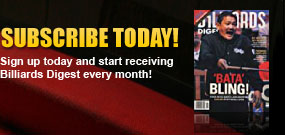The dreaded rail shots donít have to shake your confidence
For many amateurs, the shot they dread most is when the object ball is on the rail. Running a ball up the rail comes down to bad execution or improper aiming. I see it over and over again. Itís important to know how to play the shot, but even more important to know where to aim. And that depends a lot on whether or not the ball is touching the rail. Even if itís a hair off the rail, your aim point changes.
When I played English 9-ball on tight equipment I was generally regarded as the best at shooting a ball down the rail. Of course, people (even players) asked my secret. Itís all knowing where to aim on the object ball. And hours and hours of practice.
Obviously, with pocket sizes tightening up the game is tougher, and technique and fundamentals are at a premium. This is where your focus needs to be.
When practicing rail shots, itís important to move around the table. Using the same rail or same side of the table over and over isnít helpful because when you switch to the other side your eyeline and how you sight the ball is different.
Most players prefer the object ball just off the rail. This makes the pocket bigger, allowing for a little larger margin for error. The reason players struggle when the object ball is frozen to the rail is that you are trying to hit the ball and the rail simultaneously. For starters, itís the wrong way to play the shot. You must contact the ball first by a fraction before hitting the rail because the rail will compress on contact. Practice this and youíll be surprised how easy the shot is.
Letís set up a practice drill. Place the balls as show in Diagram One and practice the shots with the object ball frozen to the rail. Shot them in order. After pocketing the 1 and 2, reset the balls and shoot the 3 and 4 (Diagram Two), playing position to shoot the same sequence over and over. This will have a huge impact on your game and will clear your mind of doubt when you approach the shot in the future.

When youíve got that drill down, bring the object ball off the rail just a hair. The shot will feel easier to you but, again, donít be lazy. I still aim for more ball than rail, but when itís even a hair off the rail you can aim for both at the same time and be okay on most tables. Once the object ball is an inch or more off the rail it actually becomes trickier because the table is less forgiving if your aim is off. Train hard and dial in your contact points. The further off the rail, the more I just use the ghost ball and make sure Iím lined up before I even get down on the shot.
Keep resetting the drills and try to beat your best scores. That will help keep the drill challenging.
This all comes down to practice and understanding your stroke. Some players, myself included, like to play shots down the rail with a little outside English. You need to practice and understand your equipment. Practice these shots and youíll quickly learn a lot about your cueís deflection and your stroke.





